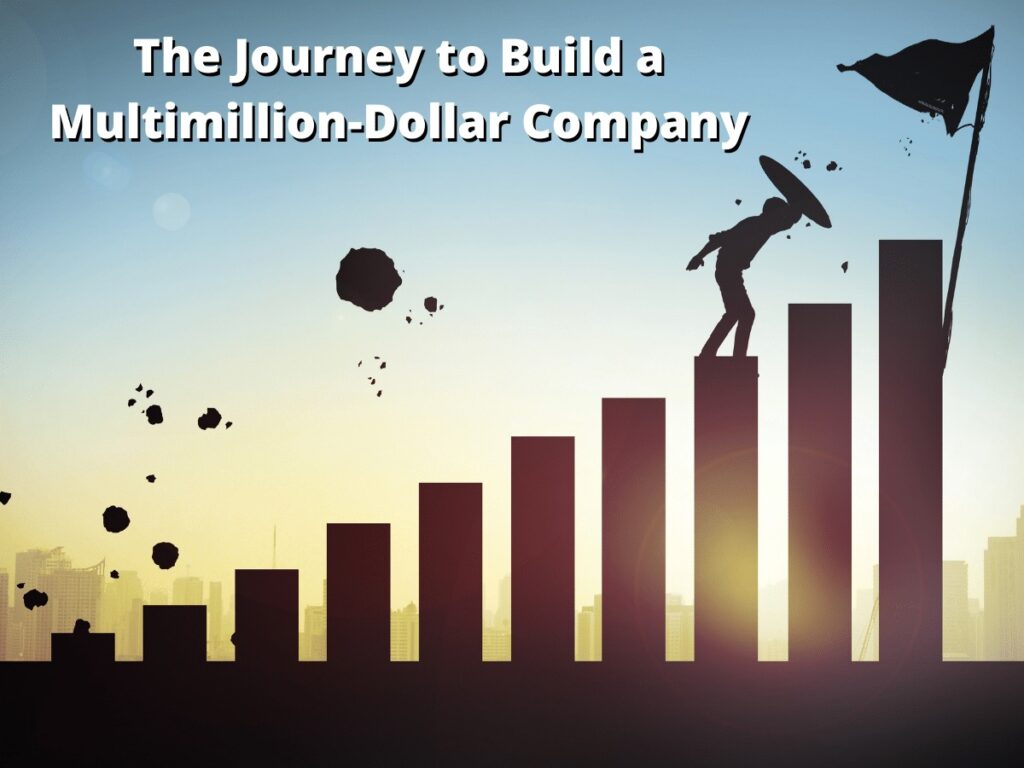 In this episode, I’m going to pull back the curtain and show you a few of the key things that happened in the early years of my company. It took me six years of training and learning before I felt comfortable enough to start my own company. Then, my new team and I spent another six years building a million-dollar per year income. However, we hit our second million dollars in just six more months. This is how we did it.
In this episode, I’m going to pull back the curtain and show you a few of the key things that happened in the early years of my company. It took me six years of training and learning before I felt comfortable enough to start my own company. Then, my new team and I spent another six years building a million-dollar per year income. However, we hit our second million dollars in just six more months. This is how we did it.
So in the late 1990s, I was having the time of my life. I was working for a huge multinational training company. Every day, I was learning new skills and growing as a business person and teacher. In fact, I was networking with some of the top consultants in the world on a day-to-day basis. My income was also growing every year. The company that I worked for had hundreds of franchises worldwide, and my boss was grooming me to purchase a franchise one day.
I was excited about the opportunity.
At our annual convention later that year, though, I was having dinner with one of my counterparts from a smaller franchise. The more I talked to him the more I realized that he was a top producer in his area and he was also flat broke. When I got back to my office, I looked up his franchise’s sales numbers. After just a cursory scan, I realized that his boss was flat broke too. Then I looked around my office. I was a top producer, so I was doing pretty well financially. However, most of my counterparts were going into debt.
A Company’s Main Purpose Is to Solve Problems for Customers.
I was working for a company that was supposed to help people become more successful, but the company couldn’t even help their own employees? That didn’t make sense to me.
This was one of those “Cloud-Parting Moments” of clarity. If you’ve ever seen the movie The Sixth Sense, it has one of the best endings ever. The theme is that we see what we want to see. That is until the moment of clarity hits us and everything becomes clearer.
My wife, Laoise, and I had dinner that night. I was in a real funk. Just like in the movie, though, I replayed memories from the past year in my head.
The company had spent three years rolling out an update to their main training program. Even a minor change took forever to implement because the company had over 3000 teachers worldwide. Each of those trainers had to be retrained for every update. As a result by the time the update completed, it was already out of date.
A lot of my income in the previous year had come from custom classes that I created based on a customer need. The programs from the company were not what the marketplace was demanding. Our customers told us what they needed and wanted, but the company didn’t listen.
Then, I mentioned to Laoise the conversation I had with my coworker, Jim. He and I went to Starbucks for coffee a few months back. Jim had mentioned that a guy who used to work for the company, Ken, had gone out on his own about ten years prior. Ken had been talking to Jim for years about jumping ship and working with him instead. I wondered if what he was doing was different.
The Bigger the Company Is, the Harder It Becomes for them to Solve Problems for Customers in a Changing Marketplace.
 Within a few weeks, Ken and I had lunch, and we really hit it off. I told him about the frustration that I was feeling. He mentioned that it was the same when he left a decade ago.
Within a few weeks, Ken and I had lunch, and we really hit it off. I told him about the frustration that I was feeling. He mentioned that it was the same when he left a decade ago.
He said, “Doug, you work for a company who is supposed to help people become more successful. The company had over 4000 employees and contractors. However, over half of those people live below the poverty line. Look closely at the revenue in the annual reports. Only a handful of franchise owners are millionaires. The rest have spent a ton of money on franchises that all compete against each other.”
He had come to the same conclusion that I had.
Ken had been in business for the last 10 years and had developed a handful of loyal customers. However, he had recently started doing classes for a local chapter of a national trade association. A couple of his clients were on the board of the local chapter, and they brought him in to do training classes for association members. The members paid a discounted fee to take Ken’s classes, and the association kept some of the proceeds as a fundraiser. So it was a win for everyone.
The Dallas chapter was in the process of merging with the Fort Worth branch of the association. They wanted Ken to teach his classes in Fort Worth as well. Ken offered to let me have the client in Fort Worth in exchange for a small portion of the revenue that I generated.
So, in March of 2000, I quit my job, put my house up for sale, and rented a cheap apartment in the ghetto of Fort Worth.
A New Company’s First Year Is Usually Pretty Lean.
The association gave me a list of their members. Email was around back then, but the association didn’t have emails for all of its members. So, Laoise and I printed brochures for the upcoming class. We sent the brochures to all of the members once a month for three months via postal mail. I spent every day calling each member, one at a time, and setting up appointments to visit with each in person. After about three months with no income and lots of expenses, I had enough people to hold my first class. I generated about ten thousand dollars in revenue, but I spent over $4,000 on printing and postage.
My net pay for the class was about $6,000. Since it took three months to fill up, I figured that I was making about $24,000 per year. If I had been working a 40-hour workweek, that amounted to about $11 per hour. However, I was working about 60 to 80 hours per week. I’d make calls and run appointments during the business day. Then, Laoise and I would stuff and lick envelopes over pizza in the evening.
After the first association class, I realized that I probably couldn’t schedule another one right away. So, I scheduled a course that was open to the public. I placed ads in the local newspaper and business journal to get new customers. In addition, I spoke at local business breakfasts, joined three different chambers of commerce, sent out lots of mailers, and did lots and lots of cold-calling. This class generated an extra $7,500, and my expenses were much higher. That year, since I had worked for my previous company the first couple of months, I netted about $27,000. (That was about a quarter of what I had made the previous year.)
My New Business Made It Through the First Year, But Just Barely.
Since I knew for a couple of years that I would need to save money, I kept my eight-year-old Corolla way past the time I should have traded it in. Then, the air conditioning went out. Our house had finally sold, though, so that helped. My wife was a trooper through the whole process. Toward the end of that first year, we found out Laoise was pregnant with our daughter, Colleen. We were still living off of a fold-out couch in our ghetto apartment, and she never complained.
Somehow, we convinced a bank to give us a new mortgage. We moved into a small home about three weeks after Colleen was born. Money was really tight, though.
Ken and I talked often about ways to grow faster. I mentioned to him some of the needs that my customers at the previous company had demanded. He was open to the ideas, but after a while, I realized that Ken was pretty stuck in the past. Ken didn’t use or teach people how to use technology in their presentations. He was photocopying his manuals and inserting them into three-ring binders. Nothing was tailored to the needs of the client.
His main challenge, though, was that he had worked for the same company that I did for years. So his idea of a business structure was almost identical. He brought me on to teach classes in Fort Worth because the company we both used to work for had a franchise in Dallas and one in Fort Worth. He believed that he had to create franchise-like offices — that was the way the big company did it.
Finally, the Business Hit a Small Growth Spurt.
 Since I needed more customers, I asked my contact at the Fort Worth association to introduce me to her counterpart down in Houston. We set up an appointment to meet at her office. I told her about the success in Dallas, Fort Worth, and Austin, but she was still a little skeptical. While I was in Houston, though, I called on the offices of some of my DFW customers who had offices there. I also made a few cold-calls. Two months later, I taught a public version of the class, and most of the participants were members of the Houston Association.
Since I needed more customers, I asked my contact at the Fort Worth association to introduce me to her counterpart down in Houston. We set up an appointment to meet at her office. I told her about the success in Dallas, Fort Worth, and Austin, but she was still a little skeptical. While I was in Houston, though, I called on the offices of some of my DFW customers who had offices there. I also made a few cold-calls. Two months later, I taught a public version of the class, and most of the participants were members of the Houston Association.
On the day of the last session of the class, I set up a follow-up appointment at the association. I showed up with a stack of exit surveys from the class that morning. My contact at the association, Susan, slowly went through each of them one-by-one. When she was finished, she looked up and said, “It seems to me that whether I say ‘yes’ or ‘no,’ you are going to do classes anyway. If I say ‘yes,’ the association receives revenue. If I say ‘no,’ we don’t. So, I guess I better say, ‘yes.'” Luckily, she smiled when she said it to me.
I spent the next couple of months driving down to Houston, staying in cheap hotels, and calling on Susan’s members. Keep in mind that this whole time I was flat broke and in considerable debt. I remember traveling down to Houston with less than $100 to pay for a hotel, food, and gas. I stopped at a McDonald’s on the way and found a “Traveler’s Guide.” Inside was a coupon for a $47 per night hotel room. Yup, I was living the high life.
After You Perfect Your Skill, You Will Also Need to Learn How to Operate a Business. There Will Be Setbacks.
The start of the third year was exciting. I was still teaching a couple of classes every year for the association in Fort Worth. In addition, I had three classes scheduled in Houston. The word was spreading, and more and more customers were coming to me versus me having to go find them. That year, I began teaching for the local association chapter Indianapolis as well. By the end of 2002, I had contracts to do two classes in Fort Worth, six classes in Houston, two in Indianapolis, and two more in Madison, WI, and Chicago.
I was still in debt, but the contracts already booked for 2003 totaled over a quarter of a million dollars. So, in just three years, I had more than doubled the revenue that Ken had generated in any of his ten years in business. In addition, my company was also continuing to grow.
At the same time, Ken was still doing his six classes every year in Dallas. His idea of growth was to bring on a single person like me in different cities. It never dawned on him that he could go to the different cities himself. That is until I did it. This was Ken’s cloud-parting moment.
At this point, Ken stopped seeing me as a partner and began seeing me as a competitor.
The Crash and the Year of Dispare.
 Our relationship devolved pretty quickly. I had spent a couple of years living in poverty to build something big. Eventually, Ken tried to take back his customer and swoop in to cash in on all the upcoming contracts.
Our relationship devolved pretty quickly. I had spent a couple of years living in poverty to build something big. Eventually, Ken tried to take back his customer and swoop in to cash in on all the upcoming contracts.
It was messy. Houston, Fort Worth, and Madison canceled all their classes for 2003. Only Indianapolis and Chicago stayed with me. I was basically starting over again. That year, CapitalOne also hired me to do a few in-house classes. In addition, since Ken was now out of the picture, I began to teach Fearless Presentations ® classes in Dallas for the first time.
However, it was a slow rebuild. Our debt was mounting up. Just before Christmas, Laoise came to me and said, “Doug, this isn’t working. We can’t keep living like this.” A friend of ours, Mary, was the Vice President of HR at a big company in Dallas. Laoise suggested that I call her and see if she might have a job for me. The next morning, I stared at my phone for what seemed like an hour. I finally called Mary.
She recognized my voice and said, “Wow, I have been meaning to call you. A couple of weeks ago, I got word that I’m being laid off. I was wondering if I could come work for you?” We both laughed when I told her why I was calling.
The Recovery and the Road to the First Million.
On December 30th, 2003, I got a random phone call from an assistant at 3D-International in Houston. His vice president was looking for a speaking coach for a team of construction guys who were competing for a project. The next day, New Year’s Eve, I drove down to Houston for a 1:00 PM appointment with them.
Turns out that this engineering company had been “shortlisted” for a project. I had never heard that term before, so I had to ask for a little explanation. When a school district, city, or big company wants to build something, they will typically send out a request for proposal. A team will then comb through the proposals to create a “shortlist” of potential candidates. Then, the shortlisted candidates will give a presentation to the committee to show why they should be awarded the contract.
Every once in a while, something happens in my life where I am absolutely sure that God is in charge of everything. This was one of those times. The association that Ken had connected me with was the Associated General Contractors. I had spent the last three years teaching public speaking classes to commercial general contractors in Houston. After a short meeting with the assistant, he left the room and brought the VP back with him. After a few minutes of speaking with him, the CEO popped in the room.
The VP looked at the CEO, and said, “I think this is our guy.” I did the coaching session for them in Dever a couple of weeks later. Then, a week after that the CEO hired me to do another session in Austin.
How I Went from a One-Man Company to a Million Dollars in Three Years.
 The CEO loved my coaching so much that he promoted me to all of his locations. For the next three or four years, I coached over a dozen teams. By the way, the teams were awarded the contracts over 80% of the time. The company grew at an exponential rate over those few years. In fact, a lot of the guys I trained became millionaires when the company was bought out by a bigger company later on.
The CEO loved my coaching so much that he promoted me to all of his locations. For the next three or four years, I coached over a dozen teams. By the way, the teams were awarded the contracts over 80% of the time. The company grew at an exponential rate over those few years. In fact, a lot of the guys I trained became millionaires when the company was bought out by a bigger company later on.
I continued to do classes for CapitalOne and the associations in Indianapolis and Chicago. However, the public Fearless Presentations ® classes started to take off in 2004. I was still doing classes in Dallas and Houston. But I also added classes in New York and Los Angeles.
Since it was just me, I would experiment with each class. The things I did that worked really well, I kept. If something didn’t work well, I trashed. By the end of the year, I had taught 20 classes, and I improved the class every time I delivered it.
Toward the end of the year, I received a call from a guy named Rick Highsmith who was looking to do some contract work as an instructor. At the time, I was exhausted. I was doing all of the selling, and the traveling, and the teaching. Then in the evening time, I work on websites and do marketing.
I really needed help by then, so I invited Rick to an upcoming class in Los Angeles. He said he would be there, but I didn’t really expect him to show. He lived in Orlando. So, a flight to California for just the potential to get a little contract teaching work didn’t seem plausible. But he showed up.
The Day I Learned the Secret to Being a Successful Entrepreneur. (Although It Took Me Almost a Year to Realize It.)
Rick and I had lunch together in the middle of the second day of class. His eyes were huge. He said, “This is amazing. First, you got 12 people to take off work to go to a public speaking class. Second, you made the whole process fun. And third, and most importantly, these people all grew substantially in just two days.” Then, he paused and said, “I’m in!”
I smiled at him and said, “Great, that makes two of us.” When I did he almost fell out of his chair.
He had seen my website and all of the cities I was teaching in. He had no clue that I was doing everything myself. (In all fairness, Laoise was doing the invoicing and bill paying etc.)
I got a virtual PBX system and forwarded incoming phone calls and emails to Rick on the days that I was teaching. After Rick started, production didn’t just double — it tripled. I taught about 15 classes in all of 2004. Then, the two of us taught that many in the next few months. We couldn’t keep up, so we brought a recent college graduate. Since we were doing a couple of classes every week, that young kid taught more classes his first year than an instructor at my previous company taught IN A LIFETIME.
By the end of 2005, we had six instructors and had delivered over 100 classes in a single year. In 2006, we had a dozen instructors and delivered over 300 Fearless Presentations ®.
If I had to do it all over again, I would do it totally differently. However, that is only because of the lessons that I learned by doing it so wrong the first time.
Here Are the Lessons Learned So You Don’t Have to Make the Same Mistakes that I Did.
- First, God Is in Control — If you are building a business, you will experience challenges. Each of those challenges will be a subtle push to change what you are doing. These pushes will someday make sense way down the road. (At the time they occur, though, they really suck!)
- Perfect Your Skill — No one wants to work for someone who just does a mediocre version of what someone else is doing. The team that joined The Leaders Institute ® early one did so because we were unique.
- The Secret to Success in Business Is Teaching Others Your Secret Sauce — Once I perfected my skill, I had just created a job for myself. That is until I brought Rick on. That is when I created wealth.
- Don’t Bring on New Team Members Until You Can Support Them — You need employees to grow your business, but if you just hire without a need, you will go bankrupt.
- Focus on Building Your Company Infrastructure — Your company will plateau at times based on your infrastructure. If you stall at the same income level for more than two years, you probably need to invest in a part of your company that is lacking. For example, marketing, finance, human resources, an executive team, etc.
The most important lesson, though is that anyone can build a big business in America. It will not be easy, and you will get knocked down. There will be times that you will feel like you have to give up. Most people will. (I almost did.) However, that moment of truth is often the time that everything will turn around for the better if you work hard and have faith.
